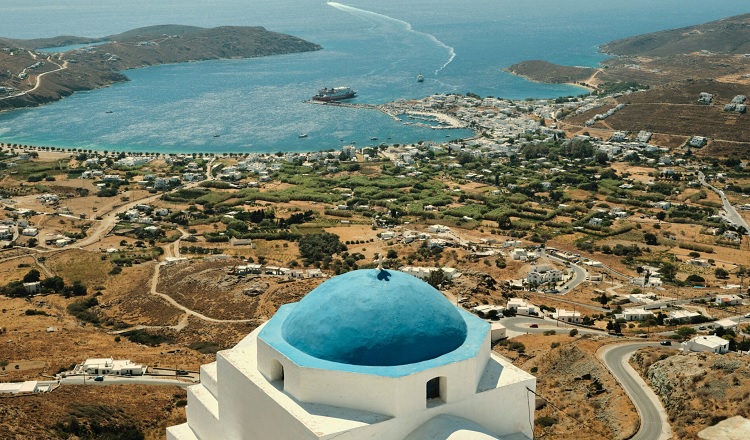
Serifos
Serifos is a Cycladic island located between Kythnos and Sifnos. Sherifos is a destination that offers something different for those seeking a new experience away from the popular destinations of the Aegean.
History of Serifos
From the early period of Cycladic civilization (around the 3rd millennium BCE), there is evidence of settlement in Serifos. During the Persian Wars, Serifos initially sided with the Persians but later switched sides and stood with the Greek forces. In 146 BCE, like the rest of Greece, Serifos came under Roman control. In 1204, when the French Franks arrived in the region, a new period began for Serifos, during which the island experienced significant cultural and economic development.
During the period of Ottoman rule, Serifos became a tributary to the Sultan. During the Greek War of Independence in 1821, many inhabitants participated in the battles against the Ottomans. During this period, Serifos again went through a phase of decline. In 1941, Serifos came under Italian administration during the occupation of Greek territories by Axis forces. After Italy's surrender in 1943, the island passed into German administration until its liberation. The recent history of Serifos is closely linked to mining activities. In 1867, the first official license was granted for the extraction of minerals.
Beaches in Serifos
- Aylomona: Aylomona Beach is the first one you will encounter when you disembark from the ship. It is essentially the natural extension of Livadi, where the port of Serifos is located. It features golden fine sand, shade from tamarisk trees, and sunbeds and umbrellas.
- Livadakia: A sandy beach located south of Livadi, with ample shade from tamarisk trees. Sandy terrain covers the entire beach and extends to the seabed, with a gradual increase in depth. Tamarisk trees are scattered along the length of the beach, providing rich shade. There are also restaurants and cafes available.
- Kalo Ambeli: This is a stunning beach on the southern side of Serifos with crystal-clear turquoise waters, surrounded by weathered cliffs. It is a small cove with transparent and turquoise waters. There are no trees on the beach, so it is advisable to bring shade and water.
- Vagia: Following the road from Livadi towards the Koutalas Bay, Vagia is the first beach you encounter before Ganema and Koutalas. It has golden, coarse sand covering the entire beach, but there are no trees for natural shade.
- Ganema: Located on the southern side of Serifos, in the Koutalas Bay, shortly after Vagia, you will find Ganema, one of the largest beaches on Serifos. It is a beach for all tastes, as half of it is covered in sand while the other half consists of white pebbles. Tamarisk trees generously provide shade along a significant portion of the beach.
- Koutalas: The third beach in the Koutalas Bay, after Vagia and Ganema. The landscape is truly beautiful here, as you can see remains of mining facilities that once operated in the area. Behind the beach, there are old buildings that served the needs of the miners. Similar to Ganema, one side starts with pebbles and gradually transitions into sand.
- Malliadiko: It is a well-protected bay shielded from winds, accessible by a dirt road. The beach is covered in coarse sand and small pebbles, with a few trees providing shade.
Sights in Serifos
- Exploring the picturesque cobblestone alleys of Chora, you will be impressed by the beautiful traditional architecture of the area. Following the alleys, you will reach the top of Chora where the ruins of the Venetian castle, built in 1434, are located. At the highest point of the cliff, you will encounter the church of Agios Konstantinos. From here, visitors can enjoy the stunning view of the Aegean Sea and neighboring islands such as Sifnos, Kythnos, Milos, and Kimolos.
- A little further down is the church of Agios Ioannis Theologos, built on the hollow of a rock above the ruins of the ancient temple of Athena. According to myth, the head of Medusa, which Perseus severed, is hidden in the underground chambers of the temple. Descending from the castle and walking through the alleys of Chora, you will come across many churches, such as Agios Georgios with a relief sculpture of a ship on its facade, the church of Stavros with the ancient spring, Panagia Xekourastra, Agios Eleftherios where the flag of the revolution was raised on May 22, 1821, and others.
- In Kato Chora (Lower Chora), you will find the Folklore Museum of Serifos, where you can enjoy exhibits from the traditional life of Serifos. Behind the Folklore Museum, there is a small theater with a capacity of 300 people, where various cultural events take place. Also, in Kato Chora, you will find the Archaeological Museum with findings from the Classical, Hellenistic, and Roman periods. In the area called Varda in Kato Chora, you will find the church of Evangelistria, built in 1907, which was once the center of Chora. A distinctive square in Chora is the Mills Square, where only three restored windmills survive today, while you can also see the ruins of the remaining ones.
